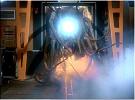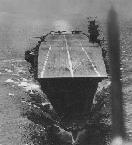Nikademus
Posts: 25684
Joined: 5/27/2000
From: Alien spacecraft
Status: offline

|
[QUOTE]Originally posted by doomonyou
[B]are you saying that a 1000lb bomb dropped from a dive bomber going a couple of hundred miles per hour wouldn't penetrate the deck armor of a warship? Even if it exploded in the deck wouldn't it tear the holy hell out of the first five or six decks, fires, etc? I understand things like the incredible mountain like armor of the Yamamoto but cruisers could take hits like that? [/B][/QUOTE]
Well in effect.....yes. :)
For one....a dive bomber screaming in at 200mph in a dive is going to tear it's wings off.
2nd, since these are non-armor piercing bombs, any signifigant armor thickness (2+ inches) is going to have a good chance of setting off even a 1000ILber whoose "armor penetrative" capabilities is very low due to being fuse initiated (and sometimes located at the nose vs the base of the bomb)
Most modern battleships had a "bomb deck" of about 1.5inches to 2.5 inches designed to initiate fuse action against bombs dropped at heights of around 10,000 feet (more velocity than a dive bomber would achieve but also much less accurate) They are also assuming a dedicated AP or semi AP bomb which are not the weapons used in UV. They are GP or more commonly reffered to, "HE"
Look at the various carrier actions of the war.....Midway was an exception as 3 of 4 carriers knocked out were set off by the incendiary effect i mentioned coupled with being in an extremely vulnerable state.
For Coral Sea, Eastern Solomons and Santa Cruz however, the big carriers of the Shokaku class, while badly damaged at times, managed to survive well despite their wooden flight decks because the bombs would essentially fuse off nearly instantly on hitting the wooden and light metal decks causing damages but more importantly causing fires or better yet causing secondary explosions if fueled planes, munitions or other volitile substances were in the area.
A CA is a bit marginal, mostly because it has less "deckage" between it and it's vitals whereas battleships often can insert additional splinter decks between the main armor deck and the vitals which help keep subsidiary damage from reaching the vital machinery and ammo spaces.....
So even if the main armor deck causes the bomb to detonate, the "splinter effect" could cause below deck damage but unless the bomb is AP or even Semi-AP, more likely it will detonate on impact and cause topside damage and fires which of course, can be dangerous if unchecked. Weapons damage to light mountings and fittings of course is permanent until repaired. It also depends on the class too. A 1st gen 'Tin clad' for example like the pair sunk in the Indian ocean would be vulnerable even to 250kg's but look at the preformance of Mikuma and Mogami at Midway? They collided, got crippled, got pounded all day from Midway and Two carriers full of SBD's and one still got away while the other only slowly surcombed with it's topsides a shambles. Thats what makes torpedoes so much more the bane of warships. Had the USN had a few intact TBD's or better yet, TBF's, the battle would have been far shorter.
I'll repost the quote i placed on the bug forum courtasy of a friend who had a source with more hard figures than myself;
"There never was a USN 500# AP bomb in WW II. Additionally, throughout 1942 there was no true. SAP or AP bomb at all, any size. In 1942 there was, for all intents, a single type of 100#, a single type of 500#, and a single type of 1,000# bomb - HE. The only variable was the fuzing, which was limited to nose and/or base fuzing that was either instantaneous or with a 1/100th second delay which does not allow for much penetration distance of anything, let alone armor!
Now, as an aside, from Pearl Harbor to Midway at least, USS Enterprise (CV-6) [I have no knowledge that any other PacFleet carrier did as well] carried a limited supply (probably one squadron load of 18) of approximately 1,600 pound battleship AP shells (14"?) that VB-6 was prepared to haul aloft to use against battleship targets. However, due to the 600# weight overload, the SBDs would have been forced to drop off at least 100 US gallons of fuel (from the doctrinal full load capacity of 228 US gallons) to do so, giving them a one way range limit of no more than 100 miles, prefeably much less. There were discussions amongst the Enterprise/TF-16 Air Staff on 6 June as to whether or not thse "bombs" should be used on against the suppected "battleships" the airgroups had been pounding all day, Mogami and Mikuma. "
Another friend quoted a 1000ILB Mark 33 bomb used in the latter half of the war that was AP or Semi AP (not sure which). This specimen was estimated to have a penetrative quality of around 5 inches if dropped from a height of 10000 feet. Note that this AP bomb still contains less than half the pen quality of the UV HE 1000ILB bomb which is rated at a whopping 250mm (almost 10 inches!)
An early war HE or GP 1000ILBer would have much less than that. Maybe 2inches if it's lucky. Carrier Taiho for example had a 3inch flight deck which was rated against 1000ILB bombs.
In short, against GP or HE bombs, it doesn't take much armor to stop them.....even more so if delivered by dive bombers as the velocity gained from being dropped at extreme heights is greater than that of a dive bomberbut of course less accurate.
The challenge of course is modeling bombs correctly. What should happen is that the incendiary effect and damage to lightly protected weapons systems should be dealt with seperately from penetrating the armor deck (and hence leading to serious SYS and FLT damage in the process)
Fire at sea can be as dangerous as progressive flooding in it's own way, and this is one small weakness of UV as i've yet to ever see fires blaze out of control in any situation. Fires can cause the internal damages that the bomb might be unable to inflict if they burn long enough. Loss of weapons mounts and radar installations are of course self explanitory.
Any serious level of protective deck, from 2nd-3rd gen CA's and BB's of course should make non AP bombs penetrating to below deck a remote possibility. Some 2nd gen CL's too such as the Cleavland and Brooklyn class CL's which were armored more on the scale of CA's.
I would suggest that 500ILB bombs, which were never anything but HE....should have a virtual nill AP quality while 1000ILB HE should have at the most, 2inches so that yes, there would be chances of success against moderately armored targets such as CA's but not the 100% it is now. This is asuming of course that the code works in the way i've suggested
If not then it might not be practical for UV though the sight of seeing my best battleships sunk solely by bombs makes me wince with pain :) If thats the case then one can only hope it can be worked into WitP
|
 Printable Version
Printable Version

















 New Messages
New Messages No New Messages
No New Messages Hot Topic w/ New Messages
Hot Topic w/ New Messages Hot Topic w/o New Messages
Hot Topic w/o New Messages Locked w/ New Messages
Locked w/ New Messages Locked w/o New Messages
Locked w/o New Messages Post New Thread
Post New Thread